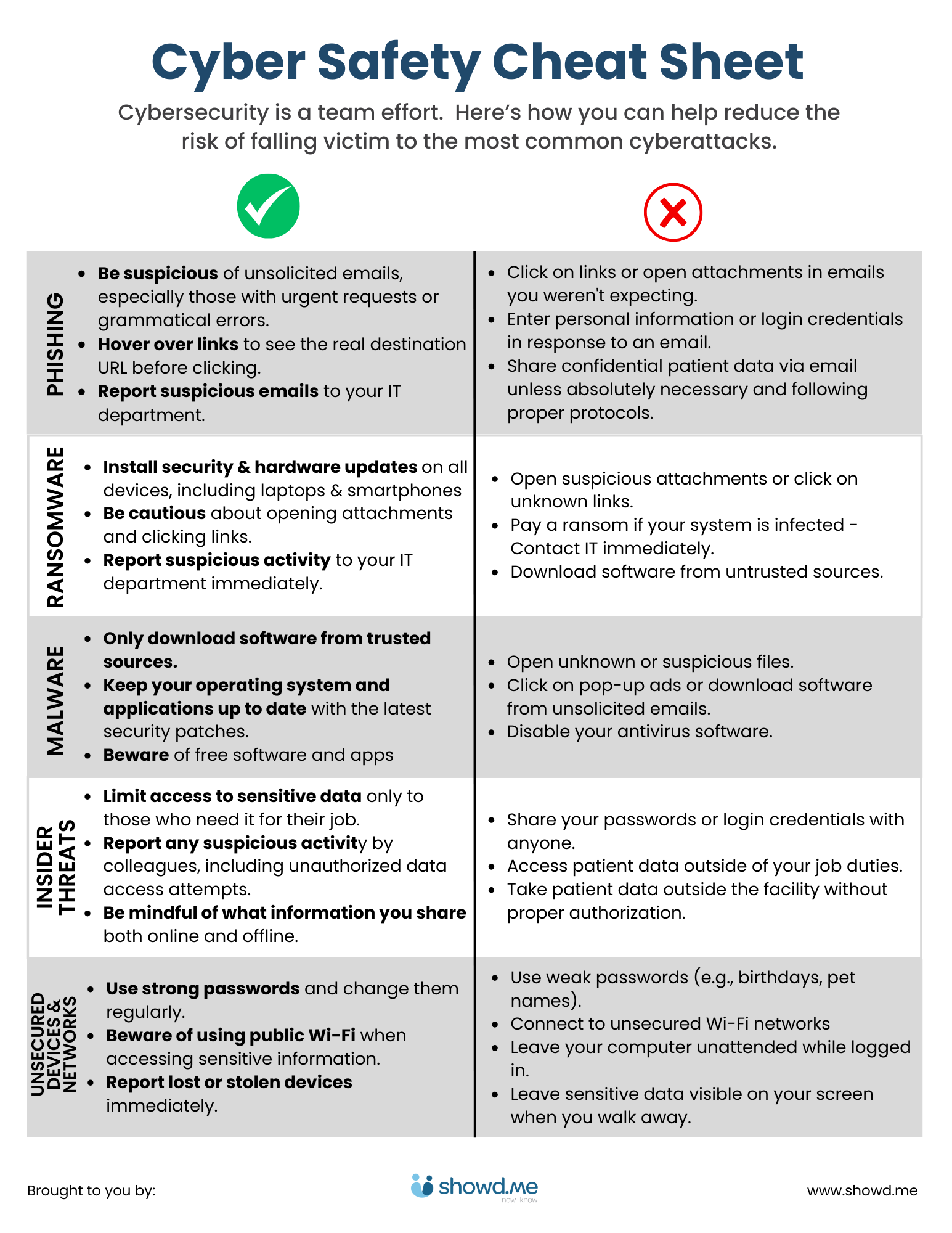Bolster Your Defenses: Training Strategies to Prevent Cyberattacks in Post-Acute Care
Post - Bolster Your Defenses: Training Strategies to Prevent Cyberattacks in Post-Acute Care
As healthcare providers, we have a fundamental responsibility to safeguard patient and resident data. Data breaches can expose sensitive patient information, disrupt crucial services, and result in both legal and financial ramifications, as well as reputational damage.
According to The HIPAA Journal, healthcare data breaches exposed over 45 million patient records in 2022 alone. And 78% of healthcare organizations have experienced a cybersecurity incident in the past 12 months, 60% of which had a moderate or significant impact on delivery of care.
The good news: proactive training is your strongest weapon against cyberattacks. By educating your staff, you can significantly reduce risk and protect your patients' privacy.
Common Cybersecurity Threats In Post-Acute Care
Cyberattacks come in many forms. But according to HHS 405(d) Program, a collaborative effort between the Health Sector Coordinating Council and the federal government to align healthcare industry security practices, these are the five most common threads facing providers today:
1. Phishing Attacks: Deceptive emails designed to trick users into revealing sensitive information or clicking malicious links.
2. Ransomware Attacks: Malicious software that encrypts data, rendering it inaccessible until a ransom is paid.
3. Malware: Malicious software that can steal data, disrupt operations, or damage systems.
4. Insider Threats: Malicious or careless activity by employees or authorized users with access to sensitive information.
5. Unsecured Devices and Networks: Lack of proper security protocols on devices and networks creating vulnerabilities.
Empower Your Staff with Cybersecurity Basics
By understanding these threats, your staff can make informed decisions to safeguard patient data. Here are key training topics to consider as part of your cybersecurity training program:
-
- Phishing Awareness: Train staff to identify red flags in emails, such as suspicious sender addresses, the use of urgent language, or grammatical errors. Teach them to verify requests with senders before clicking links or opening attachments.
- Password Security: Implement strong password policies, including minimum length and complexity requirements. Educate staff on safe password practices, like avoiding common phrases, not sharing passwords, and changing them regularly.
- Data Security Protocols: Train staff on proper handling of patient information, including secure access, data minimization, and appropriate disposal methods.
- Social Engineering Techniques: Criminals often use social engineering to manipulate users into compromising security. Train staff to be cautious about unsolicited calls or emails that request personal information.
- Reporting Suspicious Activity: Encourage staff to report any suspicious activity, including phishing attempts, malware incidents, or unauthorized access attempts. Create a culture of open communication where concerns are addressed promptly.
Training Tactics That Engage
To maximize the effectiveness of your cybersecurity training program, make sure it includes the following:
-
- Scenario-based learning: Offer courses that present real-world scenarios employees may encounter, like a patient asking for their medical records via email or a text spoofing someone at their organization.
- Quizzes: Require employees to test their knowledge with brief quizzes that hit on the key takeaways of each module, ensuring the information is retained.
- Microlearning: Break down complex topics into short, bite-sized lessons that can be viewed online from any desktop, tablet, or mobile device. This allows for microlearning opportunities throughout the workday.
Investing in your staff's cybersecurity education is an investment in your patients' safety and your facility's reputation. By proactively training your team on a regular basis, you can significantly reduce your risk of cyberattacks and ensure the highest level of care for your patients.
Ready to take action? See how showdme is helping post-acute care organizations better protect their organization from becoming the next cybersecurity headline.
Free Printable Cyber Safety Cheat Sheet
Reduce your organization's risk of cyberattacks with this free printable cyber safety cheat sheet. Our Cyber Safety Cheat Sheet offers a simple list of do's and don'ts you can provide to your caregivers and employees to reduce their risk of falling victim to some of the most common cyberattacks.
Download now and share with your employees today!

Let Us Show You More
See how showdme's unique service-first approach to training helps hundreds of healthcare organizations ensure compliance. Request a demo today!


